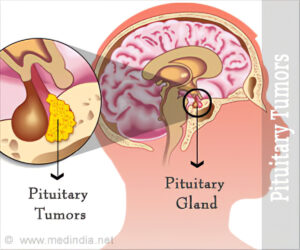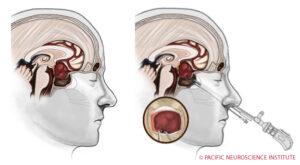What is a Pituitary Tumor?
Summary
The simple explanation of pituitary tumors would be a tumor that starts to grow in the pituitary gland. The definition of a tumor is an abnormal growth of cells. Tumors are a scary word to many people, for they can be cancerous. However, in a pituitary tumors case they are usually benign, meaning non-cancerous. Now you may be wondering what the pituitary gland is, and in short it is a part of the hypothalamus, which is a part of the brain, and it is the main control of a human’s hormones. The pituitary gland is an important part of the brain that helps humans’ function properly and control hormones.

Description
To understand the significance of a pituitary tumor, it will be helpful to further understand how the pituitary gland affects the body. The pituitary gland is an endocrine, hormone producing, gland that takes messages from the brain and turns them into hormones. It is located beneath the brain and is about the size of a pea. Although it is small it has a large role on the how the human body functions. The pituitary gland is not the only hormone producing gland in the body. There are several other glands, but the pituitary gland controls all other hormone producing glands in the body and is known as the ‘master gland’.
The pituitary gland is made of two parts, the anterior(front) and posterior(rear). The anterior pituitary produces hormones that affect breasts, thyroid, adrenal, and more, while the posterior produces hormones for the kidneys. The control of these hormones is extremely important to human development. For example, if your pituitary gland is not working correctly then it could overproduce your growth hormones and cause someone to never stop growing, or it could underproduce hormones for your thyroid and in return make you very sluggish since your thyroid controls metabolism.
As stated before nearly all pituitary tumors are benign, meaning non-cancerous, and do not spread to other parts of the body. Even though most tumors are benign they can still lead to some health problems. Since the pituitary gland is located very close to the brain, a tumor that grows to a certain size can have negative effects on the brain. A microadenomas tumor will have little effect on someone’s health, but a macroadenomas tumor will have some effects on someone’s health. A few ways someone’s health could be affect could be from an overproduction/underproduction of hormones or pressure on nerves on the brain causing headaches or fuzzy vision.

Pituitary tumors can be difficult at times to diagnose and sometimes not show any symptoms at all. Treatment for these tumors can be done surgically or by using drugs to shrink and relieve symptoms. Overall, pituitary tumors are not too common as only around 10,000 cases are diagnosed each year, with an extremely small amount being cancerous.
News Articles
This article discusses a treatment called Signifor to treat people with Cushing’s Disease, which is caused by having a benign pituitary tumor cause an overproduction of the adrenocorticotropic hormone. A study was conducted by the University of Padova, Italy to see the effects of the Signifor treatment on the disease. The researchers noted their finding as they say, “From a total of 265 patients with available tumor size data, 37.7% showed a significant tumor shrinkage following up to 25 months of treatment.”
Stress is overlooked by many people as a major health factor. In this article, this man had been dealing with a pituitary tumor and a long recovery from his surgery to remove the tumor. He dealt with a lot of stress in his life before the surgery and that was one of the reasons the tumor came to be. Changing your lifestyle to help put your health first can be very overwhelming, for you may have to give up a high paying job to ease off the stress or not do the things you once were used to doing.
Pituitary Tumor Surgery: Procedure, Risks, Recovery, Outcome (healthline.com)
Pituitary tumors are primarily treated with surgery on removing the tumor from the pituitary gland. A few different types of surgery are transsphenoidal and craniotomy. Transsphenoidal surgery is typically done to most pituitary tumors, while craniotomy is done to more difficult tumors to remove, and it comes with more risk. Most surgeries are successful but come with some risks. The recovery for a pituitary tumor surgery generally requires frequent MRIs on the gland and sometimes hormone replacements to bring your hormones back to normal.
References:
“What are Pituitary Tumors?’; cancer.org; What Are Pituitary Tumors? (cancer.org)
“Signifor Reduces Pituitary Tumor Size in Cushing’s Patients: Study”; cushingsdiseasenews.com; Cushing’s Patients’ Pituitary Tumor Shrinks With Signifor: Review | Cushing’s Disease News (cushingsdiseasenews.com)
“Surgery for Pituitary Tumors”; hopkinsmedicine.org; Surgery for Pituitary Tumors | Treatment for Pituitary Tumors | Johns Hopkins Pituitary Tumor Center (hopkinsmedicine.org)